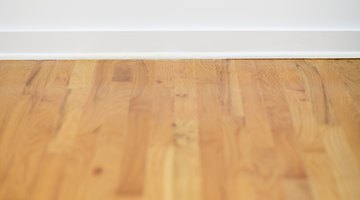What Causes My Laminate Flooring to Get a Bubble?
Laminate floors allow you to enjoy the timeless beauty of wood floors without the expense. Although there are a variety of laminate flooring products on the market, most are durable and tend to perform adequately for many years.

A bubble in the flooring may indicate a problem with the installation or with the humidity level in your home. "Peaking" is the common term for the air pockets that form beneath laminate flooring.
Tension
Laminate flooring tends to expand and contract in response to normal temperature changes. This type of flooring is also known as a floating floor because you don’t affix it to the walls or subfloor. A lack of adequate space between the flooring and the walls can create buckling, peaking and bubbling. Even with adequate amounts of space around the flooring, tension may occur when you attach the molding too tightly over the edges of the laminate flooring, limiting the material’s ability to expand and contract properly.
Expansion Joints
Large stretches of laminate flooring require expansion joints. These joints are small gaps between two sections of flooring. Bubbling caused by the excessive length and continuous weight of the laminate flooring usually occurs in stretches of flooring that run for more than 40 feet in one direction.
Moisture
Many laminate flooring products contain surface and core materials that resist moisture, although continual dampness can cause bubbling, especially in substandard products. Moisture can cause the laminate panels to swell, increasing the risk of bubbling. Installing the flooring in an incorrect manner, such as placing it directly over an existing wood floor, may limit evaporation and increase the risk of moisture damage.
Considerations
The best way to correct air pockets in your laminate flooring depends on the cause of this condition. Creating expansion joints along long stretches of flooring can help remove the bubbles. Decreasing the tension by placing smaller spacers between the walls and first sections of flooring can also encourage the boards to lie flat. A dehumidifier may help reduce excessive moisture in the atmosphere and help dry out damp boards, causing them to return to their original form. If your flooring is new, determine whether you have a warranty that may help you replace substandard products. If a flooring contractor installed your laminate flooring, ask the company to come back and inspect the problem area.
The Drip Cap
- Laminate floors allow you to enjoy the timeless beauty of wood floors without the expense.
- This type of flooring is also known as a floating floor because you don’t affix it to the walls or subfloor.
- Installing the flooring in an incorrect manner, such as placing it directly over an existing wood floor, may limit evaporation and increase the risk of moisture damage.
- Decreasing the tension by placing smaller spacers between the walls and first sections of flooring can also encourage the boards to lie flat.
- If your flooring is new, determine whether you have a warranty that may help you replace substandard products.
References
- Laminate Flooring: Laminate Floor Repair – Common Issues
- The Essential Guide to Laminate Floors; Johnnie Ward
Writer Bio
Laura Wallace Henderson, a professional freelance writer, began writing in 1989. Her articles appear online at Biz Mojo, Walden University and various other websites. She has served as the co-editor for "Kansas Women: Focus on Health." She continues to empower and encourage women everywhere by promoting health, career growth and business management skills.
Photo Credits
- Jupiterimages/Brand X Pictures/Getty Images
- Jupiterimages/Brand X Pictures/Getty Images
More Articles


